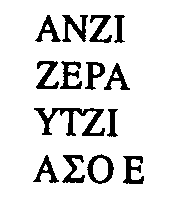
Limestone block from Silistra, now at the Museum of archaeology in Russe. Height of the letters: 0.06-007. At the top edge of the block: a recess with the form of a bowl.
Inscriptions

Transcription in Proto-Bulgarian:
OHSI (or OSHI) CHIT MA GILS
Translation:
OF OCH (or OSH) HONOUR THE URN
For details of the translation see P. Dobrev, Op. cit., p. 105-107, as well as the first section of this book.
2.
Limestone block from Silistra, now at the Museum of archaeology
in Russe. Height of the letters: 0.06-007. At the top edge of the block:
a recess with the form of a bowl.
Publications: V. Beshevliev. IAI. XX 287. No. 19, Photo; V. Beschevliev. Urbulgarische Inschriften. S., 1979, S. 239 Figure 193; P. Dobrev. The Proto-Bulgarians ..., p. 104-105.
Transcription in Proto-Bulgarian:
ANSI ZERA ITZI (or IZI) ASO E
Translation:
OF ANZA THE MESSENGER HERE DOWN THE ASH IS
It was a grave inscription placed above an urn. As far as funerals in urns was common for the Proto-Bulgarians during the pre-Christian epoch, the inscription originates most likely from the time before 865 AD.
3.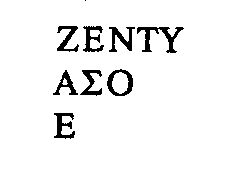
Limestone block from Silistra. Now in the Museum of archaeology in
Russe. Height of the letters 0.065.
Publications: V. Beshevliev. IAI XX 287, No. 20,
Photo; V. Beschevliev. Urbulgarische Inschriften, S. 238, Figure
194; P. Dobrev. The Proto-Bulgarians..., p. 103-104.
Transcription in Proto-Bulgarian:
ZENTI ASO E
Translation:
OF ZENTA THE DUST IS
As follows from the translation, the inscription is fragmentary. The size of the stone, into which it was carved, shows that it was placed above the urn of an unknown Proto-Bulgarian.
4.
Part of a marble plate with a relief cross. Height 0.15, length 0.246,
thickness 0.06. It was found in a small court church in Pliska. Kept in
the Varna museum of archaeology (Inv. number III-182).
Publications: F. Uspenski. IRAI X, 265;
V. Beshevliev. Early-Bulgarian Inscriptions. p. 204. Fig. 196.
Transcription in Proto-Bulgarian:
Left side: OHSI (or OSHI) JOVOK EALH
Translation: OF OSH - SLAVE (OF THE GODS) IS THE DUST
Right side: AE OSOA OLH
Translation: OF AJA, HIS WIFE THE SIGN
Beshevliev regarded the both sides as one inscription. Details about the present translations here and about the reasons why I am at the opinion that there are two inscriptions, can be seen in the text above.
5.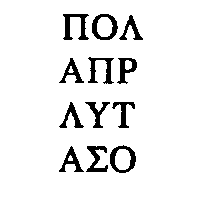
Partly preserved inscription on a stone with a joint, discovered in
1954 by Sh. Vazharova near the village of Popina.
Publications: Sh. Vazharova. Slavo-Bulgarian settlement
near the village of Popina, S., 1956, p. 19. Fig. 10; V. Beshevliev.
Early-Bulgarian Inscriptions. p. 240, Fig. 195.
Transcription of the preserved parts:
POD APR LUT ASO
Translation:
OF PODIGAR THE COURAGEOUS HERO THE ASHES
6. 
Part of a limestone block. Height of the letters 0.07. Kept at the
Silistra Museum.
Publications: V. Beshevliev. Early-Bulgarian Inscriptions.
p. 241, Fig. 197.
Transcription in Proto-Bulgarian:
EPI ITIP BILO
Translation:
OF EPO - THE WISE THE URN.
It was a grave inscription. V. Beshevliev read the first word as SPI, but he acknowledged that it can be read as EPI as well. For details about the deciphering and the translation see above in the text.
Inscription on one of the golden cups of the treasure from Nagy Saint-Miklos
in Hyndary, discovered in 1799. Kept in a museum in Vienna.
Publications: St. Mladenov. DIE INSCHRIFTEN des
altbulgarischen Schatzes von Nagy Saint-Miklos, im Banant. GHM, 4 1922/1923.
In Greek letters:
VOILA ZOAPAN TESI DJUGETOIGI BOITAUL ZOAPAN TAGROGI IZIGI (or ICHIGI)
TAISI.
Proto-Bulgarian translation:
BOILA ZHOAPAN TEZI DJUGETOIGI BOITAUL ZHOAPAN TAGROGI IZIGI (or ICHIGI)
TAISI.
8.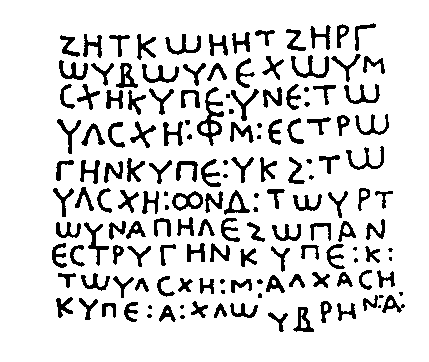
Inscription on a (granite) plate, discovered in area of Bjal Brjag
near Preslav. Height 2 m. Now in the Preslav Museum (Inv. number 3212).
Publications: I. Venedikov. Proto-Bulgarian inscription
discovered in Preslav. IAI XV, 1946, 146-180, with facsimile and photo;
V. Beshevliev. Early-Bulgarian Inscriptions. p. 186 and Fig. 134, 135.
Translation: See details in Chapter 1of this book.
Fragments
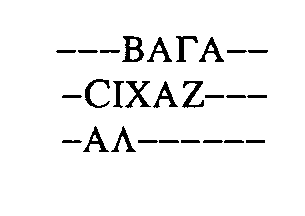
Transcription:
... VAGA .. (or (BAGA)
..SIHAZ ..
..AL ...
Translation: The first word could be "bagain" or "bagatur", as
stated by V. Beshevliev. The last word resembles the term EALH from the
two grave inscriptions found in Pliska. A probable reconstruction is:
OF THE BAGAIN (or BAGATUR) THE MORTAL REMAINS
2.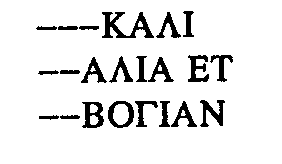
Inscription on a framed plate discovered in the Small Palace in Pliska.
Publications: V. Beschevliev. Early-Bulgarian
Inscriptions. p. 124.
Transcription:
..KALI
..ALIA ET
..A BOGIAN
....
Translation: Most certain is the V. Beshevliev's interpretation of the word BOGIAN as being the Proto-Bulgarian personal name of BOJAN. In Greek the intermediate consonant "G" was inserted between the two vowels of (other) names of the type of BOJAN, and BOGIAN written with Greek letters can be a derivative of that Proto-Bulgarian name. The remaining words are unclear. The word KALI in the first line can be connected with the Proto-Bulgarian word KALI (woman), which was discovered by I. Folor. But as far as there are also similar Greek words, the question of the meaning of this fragment remains unsettled.
3.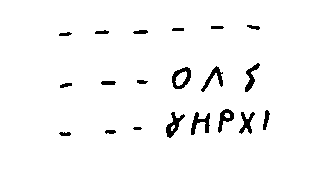
Fragment of a block from the area of Armugluk in Pliska.
Publications: St. Mihajlov. Excavations and investigations,
III, 1949, p. 179 and the next; V. Beshevliev. IAI, XX, 1955, 281,
No 6 with a photo; V. Beschevliev. Urbulgarische Inscriften. p. 126.
Transcription:
...
...OL=
..UIRHI
Translation: The double sound UI in the word UIRHI, as well as its ending -I suggest that the inscription is Proto-Bulgarian since words with this double sound and an ending of this type are frequently found in the Proto-Bulgarian epigraphic material. On an Indo-European basis (Celtic and Iranian) the term UIRHI can be compared with words such as VIR, FIR (man, hero) and the ending HI is probably a version of the well known dative ending -I and -GI.
The first word OL, or perhaps also OLH, can be compared with the term OLH (sign) from another grave inscription (see above) discovered also in Pliska. In that case it can be translated as follows:
---
--SIGN--
--OF THE HERO---
4.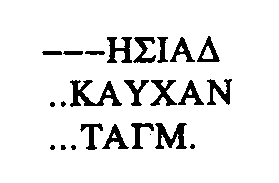
Inscription on a limestone block from the area Armugluk in Pliska.
Kept in Pliska. Inv. number 1827.
Publications: St. Mihajlov. Excavations and investigations,
III, 1949, p. 180; V. Beshevliev IAI, XX, 1955, p. 125 and Fig. 60.
Transkription of the preserved section:
...ISIAD ... KAVHANOS ... TAGMA
Translation:
HERE (?) OF THE KAVKHAN ... TAGMA
Up to now most certain is the translation of the second word KAVHANOS, since it is also found in a number of other Proto-Bulgarian inscriptions with Greek letters, and it is not different from the well known court title "Kavkhan" as noticed by the first interpretator V. Beshevliev. The translation of the other two words is uncertain. If the combination ISI in the first word has something to do with the word ITSI from other Proto-Bulgarian inscriptions, it can be translated as "here".
And if "AD" has something common with the characteristic for some Iranian languages expression "ad" (below), then "isiad" can be translated as "here down". As correctly noticed by Beshevliev, two different interpretations are possible for TAGMA: one from the Greek point of view and one - of the point of view of the eastern languages. That is why the contents of the inscription remained unclear so far.
5.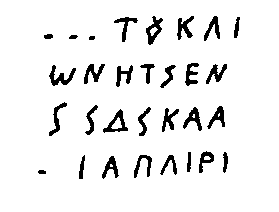
Part of a marble column found in Pliska, today at the Pliska museum.
Publications: V. Beshevliev. IAI, XX, No. 1, 1955,
277 and Fig., with a photo; V. Beshevliev. Early-Bulgarian Inscriptions.
p. 126.
6. 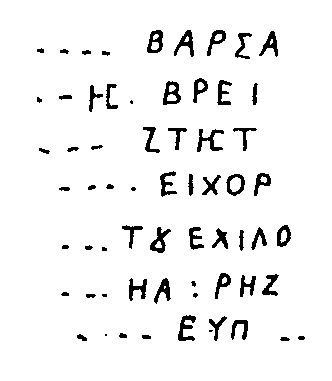
Large fragment of a limestone plate, discovered in the area of Shumen.
Dimensions: height 0.525, width 0.41, thickness 0.14. Kept at the Shumen
museum of archaeology, inv. number 15317.
Publications: V. Antonova. Newly discovered Proto-Bulgarian
inscriptions from the village of Dlazhko. INM-Kolarovgrad, III, 1965, 25-29.
1957, 222-224. Facsimile and photo; V. Beshevliev. Proto-Bulgarian
epigraphic monuments, p. 181, Fascimile 25.
Transcription:
... VARSA
IS.. VREI
..STIST
.. EIHOR..
..TUEHILD
IA:RIS
...EIP.. RIS
Translations: Although the inscription is on a single plate the reconstruction is difficult. V. Beshevliev noticed that there are no words such as VARSA and VREI of Greek origin, but the comparison of VARSA with VARS and particularly VREI with BIRI raises a number of questions. Likewise, it is not certain whether the damaged character before VARSA and VREI must be read as O. The attempt to find exact interpretation for the word VREI or BREI (as Beshevliev assumes) led to the Celtic languages with terms such as BRE (height, high place) and BRUI (admire). There are, likewise, words such as BARS (singer), VARSA (I entertain myself, I am merry), etc. Of Celtic origin are also other words (or fragments) such as STIST (Celtic istis - to conquer), KEIHOR and KEIPLAN (viz. kel (house) and plan (full)). But because of missing separators between the individual words we cannot completely translate this very interesting inscription yet. As far as this inscription exhibits many Celtic elements (which are common with Iranian) it can be assumed that the text is a Proto-Bulgarian inscription.
Another feature is important. Between the Greek letters are carved Proto-Bulgarian
runic characters, as can be clearly seen from the photos of the inscription
and from the palaeographic analysis of Prof. Beshevliev. Thus for example,
it is quite clear that the character ![]() in the first line is also found in the runic inscriptions from Murfatlar.
In the second line, the character
in the first line is also found in the runic inscriptions from Murfatlar.
In the second line, the character ![]() is known from Murfatlar and Bjala. In the third line appears again
is known from Murfatlar and Bjala. In the third line appears again ![]() ,
and between the fourth and fifth line - the character Y. Why were
these characters inserted between the Greek letters is not known. It is
however interesting that on the rear side of the plate with inscription
is to be seen a drawing of a Proto-Bulgarian pagan sanctuary, represented
by two nested one into another rectangles. The same drawing, accompanied
by the explainatory word ARKON (sanctuary) was discovered among the Proto-Bulgarian
runic inscirptions in Murfatlar. Additionally, on the edges of the plate
(17 cm broad) there are schematic drawings of horses performed in the characteristic
Proto-Bulgarian style. That confims the Proto-Bulgarian origin of both
inscription and runic characters. Applying the interpretation of these
characters given by the Soviet palaeographers, the character in the first
line reads AN (
,
and between the fourth and fifth line - the character Y. Why were
these characters inserted between the Greek letters is not known. It is
however interesting that on the rear side of the plate with inscription
is to be seen a drawing of a Proto-Bulgarian pagan sanctuary, represented
by two nested one into another rectangles. The same drawing, accompanied
by the explainatory word ARKON (sanctuary) was discovered among the Proto-Bulgarian
runic inscirptions in Murfatlar. Additionally, on the edges of the plate
(17 cm broad) there are schematic drawings of horses performed in the characteristic
Proto-Bulgarian style. That confims the Proto-Bulgarian origin of both
inscription and runic characters. Applying the interpretation of these
characters given by the Soviet palaeographers, the character in the first
line reads AN (![]() ),
and in the second - JU (
),
and in the second - JU (![]() ).
These two words mean in the Celtic languages PLACE OF WORSHIP, SANCTUARY.
It is in agreement with the words written in Greek letters and it allows
us making further conclusions about the words written in Greek letters.
It is very probable that first two lines of the inscription read : VARSAISIOBREI
or OBARSAISIOBREI, i.e. OF VARS ADMIRATION OF THE GOD JUPITER. The letters
which can be detected after IS suggest that there was a word IO (or UO)
meaning Jupite, as found in two other Proto-Bulgarian inscriptions.
).
These two words mean in the Celtic languages PLACE OF WORSHIP, SANCTUARY.
It is in agreement with the words written in Greek letters and it allows
us making further conclusions about the words written in Greek letters.
It is very probable that first two lines of the inscription read : VARSAISIOBREI
or OBARSAISIOBREI, i.e. OF VARS ADMIRATION OF THE GOD JUPITER. The letters
which can be detected after IS suggest that there was a word IO (or UO)
meaning Jupite, as found in two other Proto-Bulgarian inscriptions.
7.
Part of a stone column - 42/40 cm, found in a church near the village
of Chatalar. At present in the Preslav museum. Inv. number 2599.
Publications: I. Venedikov. Three Proto-Bulgarian
inscriptions. In: Excavations and investigations, 4, 1950, No. 2, 177-81
(in French); V. Beshevliev. Early-Bulgarian Inscriptions. p. 189
and Figures 136-137.
Transcription:
...ORI...
...OKATU..
...ED KANE..
...N KOUPESI PS
..SI KUPESI PG
..OSH KOUPESI PE
Translation: So far only the interpretation of the word KUPESI is certain. It is a derivative of the Proto-Bulgarian word KJUPE (armour) known from the Preslav inscription. The expression ..N KOUPESI PS.. can be reconstructed as "ESTROGIN KUPESI PS", i.e. 'mail armour 86 pieces'; and the expression ..SI KUPESI PG.. as "HUMSHI KUPESI PG ", i.e. 'cast armour 83 pieces'. Behind the partly preserved OSH is probably hidden a word of the type FAROSH - a mount, so that the last part can be translated as "armour for horses 86 pieces ".
Here we find two forms of the term armour -KJUPE and KUPESI. Similar examples are found also in the Caucasian languages - even nowadays there are two designations for armour (and for clothing at all) in Caucasus - words of the type KAEBA, KOBE, KEAPA and words of the type KIABACHI, KOBECHI, KAVASI, HAPACHI, which all have the same meaning. In individual cases both forms are met in the same language - keaba and keabachi, or keapa and hapachi. Such examples are particular to the Andiian and Archinian languages in Dagestan. The suffix "SI" in KUPESI has, likewise, a long history. In Caucasus this suffix appears in three forms - as "SI", "SHI" and "CHI", with their assistance is formed the majority of nouns. These different forms are observed in the Proto-Bulgarian inscriptions as well. With their assistance were formed words such as kupesi (armour) and tulsi (TULSHI) - helmet, and adjectives such as alhasi and humsi (HUMSHI). Thus, there are parallels in these grammatical forms between the Proto-Bulgarian and the Caucasian languages. Looking further back into the past these special forms can be compared with the Sumero Accadian suffix "sju" which, among other things, appeared in words such as hunsju (casting), tulsju, etc. The same old suffix is also met in some eastern Iranian languages, for example in Sogdian, with words such as medanchi (means) and nouns such as patisinchi (acknowledgment), shekarchi (pursuit), etc. But in Sogdian this suffix formed mainly abstract words, while in our case it formed particular words. In this case the Caucasian examples are closer to the Proto-Bulgarian than to eastern Iranian ones.
[Previous] [Next]
[Back to Supplements]